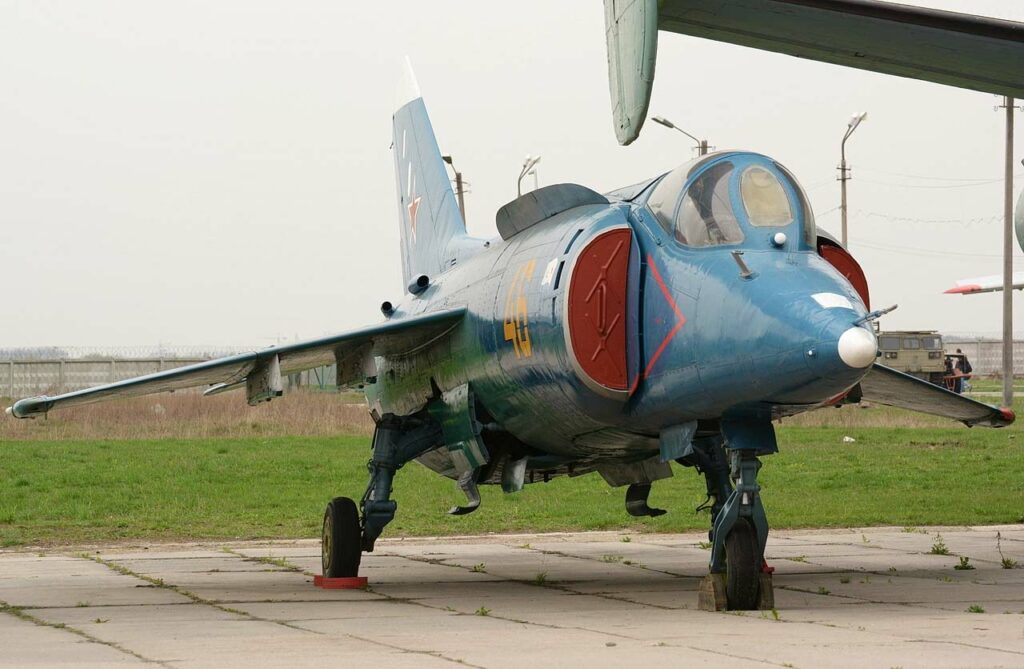Yak-38 Forger: Soviet naval VTOL jet designed for carrier operations.
In brief
The Yakovlev Yak-38 (NATO reporting name: Forger) was the Soviet Union’s first and only operational VTOL (Vertical Take-Off and Landing) fighter used primarily by the Soviet Naval Aviation. This aircraft, which first flew on January 15, 1971, and was introduced in 1976, was developed to operate from aircraft carriers. Powered by one main thrust engine and two vertical lift engines, the Yak-38 could achieve a top speed of 800 km/h with a range of approximately 1,300 kilometers. It was equipped for light attack missions, capable of carrying a payload of up to 1,000 kg including bombs and air-to-air missiles, making it versatile in its limited role. The design focused on providing the Soviet navy with a fast deployment airborne capability, though it was hindered by performance limitations in payload and range compared to contemporary aircraft.

History of the Development of the Yakovlev Yak-38 (Forger)
The development of the Yak-38 began in the mid-1960s as the Soviet Navy sought a naval air power that could operate from the decks of its growing fleet of aircraft carriers and other large vessels. This need was in response to the expanding capabilities of Western navies, particularly the U.S. Navy, which had been demonstrating increasingly sophisticated carrier operations. The Soviet Union required a versatile aircraft that could launch and land vertically, enabling rapid deployment without the need for traditional carrier launch and recovery systems.
The Yak-38 program was spearheaded by the Yakovlev Design Bureau, with the primary objective of creating a VTOL fighter that could support naval operations in various theaters, particularly in the confined waters of the North Atlantic and the Mediterranean. The aircraft was designed to enhance the combat versatility of the Soviet fleet, providing cover and close air support for naval vessels and amphibious landing forces.
The Yak-38 made its first flight in 1971, and after several years of testing and development, it was officially introduced into service in 1976. The aircraft was a significant technological step for the Soviet military aviation, being the first operational Soviet VTOL aircraft. It was developed during a period marked by intense Cold War competition, where naval power projection became increasingly important for both NATO and Warsaw Pact forces.
Design of the Yakovlev Yak-38 (Forger)
The Yak-38 was uniquely designed with two Rybinsk RD-36-35FV lift engines positioned behind the cockpit solely for vertical take-off and landing, and a single Soyuz R-27V-300 engine installed in the rear for horizontal flight. This configuration allowed for VTOL capabilities, essential for operations from smaller Soviet aircraft carriers, which lacked catapult systems.
The aircraft measured about 16.37 meters in length with a wingspan of 7.32 meters, and an empty weight of 7,385 kilograms, enabling it to carry a maximum takeoff weight of approximately 11,300 kilograms. Its structure was optimized for the stress of vertical takeoffs and landings, incorporating lightweight materials and a robust landing gear.
However, the Yak-38 had several drawbacks, primarily its limited range and payload capacity, which were compromised by the space and weight demands of the VTOL system. Additionally, its performance was limited by the relatively low power-to-weight ratio, affecting its agility and speed compared to conventional aircraft like the U.S. AV-8 Harrier.
Performance of the Yakovlev Yak-38 (Forger)
The performance parameters of the Yak-38 included a maximum speed of 800 km/h, a range of 1,300 kilometers, and a service ceiling of 12,000 meters. The aircraft’s operational radius was relatively short, which limited its effectiveness in extended combat scenarios. Its VTOL capabilities were also constrained by high fuel consumption during takeoff and landing phases, reducing its overall mission endurance.
When compared to its Western counterpart, the AV-8 Harrier, the Yak-38 generally fell short in terms of speed, range, and payload capabilities. The Harrier’s more advanced Pegasus engine offered greater efficiency and power, allowing for a higher payload and longer range.
Variants of the Yakovlev Yak-38 (Forger)
The primary variants of the Yak-38 included the Yak-38M, which featured improved engines and avionics, enhancing its operational range and payload capacity. Another variant, the Yak-38U, served as a two-seat trainer model, providing training capability without the need for a conventional runway.

Military Use and Combat of the Yakovlev Yak-38 (Forger)
The Yak-38 saw limited combat use, primarily involving exercises and patrol operations. It was deployed during the Soviet war in Afghanistan, where its capabilities were tested under combat conditions, but it was not widely used in major battles. The aircraft served mainly on the Soviet aircraft carriers such as the Admiral Gorshkov.
As technological advancements continued, the limitations of the Yak-38 became apparent, leading to its gradual phase-out in favor of more capable aircraft. It was officially retired from service in the early 1990s following the dissolution of the Soviet Union, replaced by more advanced naval aviation technologies.
The Yakovlev Yak-38 was a pioneering aircraft for the Soviet Union, marking its initial foray into VTOL technology. Despite its operational and performance limitations, the Yak-38 provided valuable lessons that influenced future Soviet and Russian aircraft designs. Its development underscored the challenges and complexities of VTOL technology, particularly in a military context, highlighting a significant period in Cold War military aviation history.
Back to the Fighter Jet section.